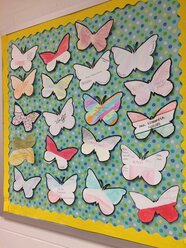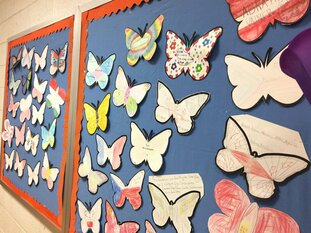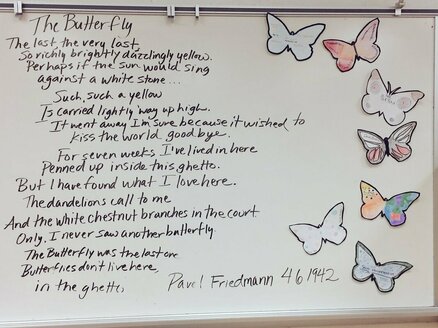 This week we are wrapping up our unit on the Holocaust and I thought that I would share the ways in which I guide my students through this difficult topic in the hopes of giving fellow history teachers, especially novice teachers, some ideas. It can be extremely challenging to teach middle school students about the Holocaust for a number of reasons. First, the subject matter is hard (and despite what people may think many of my students have not learned about it before) and can hit home for some students based on personal history. Second, this topic requires students to be their most mature selves (which can require a great deal of teacher guidance and modeling in the middle years). That said, if it is done right, these lessons of one of humanity's greatest tragedies can stick with them for life. I, like so many teachers, teach history not only because I love the subject but also because I feel like the lessons of our history -- if instilled in our young people -- can guide the world toward good. So here are some of the resources and ways that I teach the Holocaust. I hope that they might help you in your teaching journey. Day 1: The Causes and Terminology First, I am always upfront about the difficult nature of the topic — explaining that it is sad and horrifying. I let them know that if they need to take a break they should. Next, we begin with a warm-up question in which students share on paper independently what they know about the topic. They then share with a partner. This a way of demonstrating that we are all approaching the Holocaust with different levels of knowledge and that that's okay. Next, we explore a timeline of events. Students annotate the timeline, asking questions of the text (this timeline is simple, but there are others available that are more in-depth). Then, we discuss the timeline and I make sure to highlight key vocabulary terms —- such as ghetto, selection and concentration camps. We end the day by beginning to watch We Must Never Forget: The Story of the Holocaust. I use this film in my teaching because it is geared toward middle school students and most importantly, it chronicles the story of a survivor, Rosa Katz. She lived in Poland and was sent first to a ghetto and then to Auschwitz. Her tale is riveting and she tells her story with bravery and grace. I believe it is essential that students learn about the Holocaust from someone who lived it. Day 2: A Survivor's Tale of the Ghetto and Auschwitz On the second day, we fill out a graphic organizer, recapping what we have learned so far from the film. We use a mind map to detail the causes of the Holocaust and the conditions in the ghettos. Next, we return to the video, watching Rosa discuss her time in the ghetto and then her time in Auschwitz. Throughout the video viewing I stop it to ask questions and to clarify the tale that Rosa tells. I also provide plenty of time for students to ask questions. We end by mind mapping the experience in the concentration camps. Day 3: A Plea for a Better Future/I Never Saw Another Butterfly On the third day, I have the students begin by in their warm-up detailing the who, what, when, where and why of the Holocaust. They then share their answers with their table partners. This allows us to learn from one another -- to figure out what we know so far, what we need to clarify and what questions we have that remain. We then finish the film, which describes how Rosa escapes, and is followed by what I believe is the most important part of the film. Rosa, looking directly into the camera, asks young people to reject hatred and bigotry. "You are our future," she says imploring students to never let something like this happen again. We close by reading Pavel Friedmann's poem, The Butterfly. I explain to students that this poem was written by a young man during the Holocaust. He later died in Auschwitz (you can read more about his story here). We discuss what the butterfly and the color yellow (found throughout the poem) might symbolize. Students ponder its meaning with a variety of answers -- perhaps the yellow represents the Yellow Star of David. Maybe the butterfly represents life, hope, freedom, happiness, youth. Their answers -- all thoughtful -- vary. In an effort to share with students the scale of the suffering caused by the Holocaust, I tell them that if the world was silent for one minute for every Jewish victim of the Holocaust that we would be silent for 11 years. They stare at me, their minds turning over the vastness of that horrible number: six million. I explain that if we include other victims of the Holocaust -- Jehovah's Witnesses, Homosexuals, and Disabled people -- the years of silence grow to 22.  Day 4: Grief, Honor and Action I feel like it can be easy feel helpless after learning about these horrors of the past; I want the opposite for my students. I want them to feel empowered, to be agents of change and so we set out to honor the victims of the Holocaust by making our own memorial. I learned about the Butterfly Project a few years ago and knew that this was the perfect fit for middle school students. I provide students with a list of names of children and teen Holocaust victims. They select a name and create a butterfly in this person's honor. I explain that given the vast number of victims that this may be the first time that someone has created a butterfly in their name. That provides my students with connection and purpose. And so we create our butterflies — and as I watch my students add their colors to their butterflies, I am filled with hope. In a few days their butterflies will grace our main hallway, surrounding the poem The Butterfly. Day 5: How will you be the change? In closing, I provide students with information about the recent rise in anti-semitism. I tell them stories of students at our school who have told me that the Holocaust never happened (deniers in our midst). I relay to them the events of Charlottesville, a mere 90 miles away hoping to instill in them the understanding that the threat of hatred remains real in 2019. And then in closing, I ask them to journal about what they can do in their lives (in big and small ways) to make sure that we never forget -- and that this never happens again. In a few weeks, our students will read The Diary of Anne Frank in English, allowing them to build upon their work in history as they make connections in other classes. How do you teach the difficult topic of the Holocaust? What resources do you find valuable? When we share, our students are better for it and so is the world. -Corey You might also like:
0 Comments
Your comment will be posted after it is approved.
Leave a Reply. |
Who We Are
Join our list!Archives
September 2020
Categories
All
|







 RSS Feed
RSS Feed